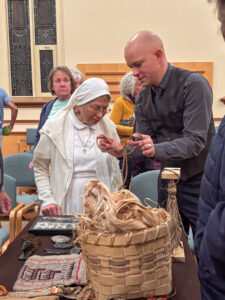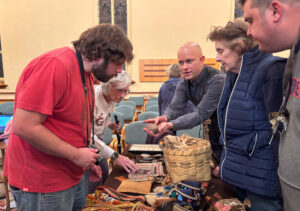Taylor Moyer gives presentation on American Indians of the Great Lakes Region
By Sheri Trusty, Seneca County Media Relations Coordinator
Retired Heidelberg University Department of Biology and Environmental Sciences professor, Ken Baker, hosted one of the most unique events tied to Seneca County’s bicentennial when he invited American Indian historian Taylor Moyer to present two talks on the history of Great Lakes Native Americans. Moyer is the Historic Programs Manager for the Black Swamp Intertribal Foundation.

Moyer presented “History of the First Nations People of Northwestern Ohio” on Nov. 6 at Heidelberg University. On Nov. 13, he presented “Traditional Culture and Arts of the American Indians of the Great Lakes Region” to a packed crowd at the Chapel at Sisters of St. Francis Convent. Moyer gave a captivating talk on foundational inspirations behind American Indian art.

Although some American Indian art is esthetic, much of it has spiritual significance. Moyer explained that significance and the resulting cultural drive to protect and honor Native American artifacts. The American Indian culture is founded heavily on a belief in Manitou, the omnipresent creator of all. Moyer said that American Indians sometimes embarked on vision quests to connect with Manitou, and through those experiences, an animal, voice or spirit would become manifest.
Those animals, which served as guardian spirits, are often integrated into their functional and aesthetic art and can be found in spoons, pipes, pottery and more. Moyer brought a number of artifacts and modern Native American art to his presentation.
Moyer discussed many spiritually significant elements of the art, including circles and sacred herbs. He also tied the ancient Native American culture to modern history. The Shawl Dance, he said, was born during World War II as a way for American Indian women to honor returning soldiers. Moyer said many American Indian men fought in the war to protect their homeland, playing a significant role in Allied victory. The women wore brightly colored, flowing shawls as they danced below incoming planes carrying soldiers home.
“The women wanted the men to see them from the sky, so they wore bright shawls,” Moyer said. “The men said they looked like butterflies.”
Moyer said the American Indians’ philosophy of life is founded on a belief that you plan for the seventh generation after you. That philosophy fits well with the Seneca County Commissioners’ efforts to improve the county for future residents. Many of their current projects create long-lasting protections for Seneca County.
“You have to make decisions based on the seventh generation after you,” Moyer said. “Can you sleep at night knowing the decisions you make today will set them up for success?”

The Seneca County Commissioners honor the long, colorful history of Seneca County, which celebrates its 200th birthday in 2024.
